|
|
|
 |
|
|
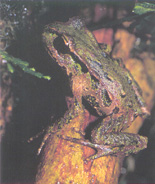 |
|
| |
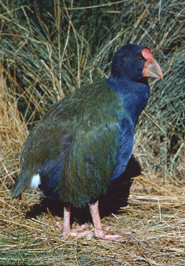
|
|
 |
|
 |
|
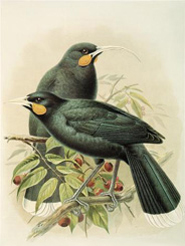
|
|
 |
|
 |
|
| |

|
|
| |
|
| |
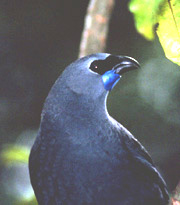 |
|

Insects' instincts boost population
"Whether it is down to good sex or good science, it is a giant leap forward in the conservation of one of our rarest insects"
New Zealand Herald
2 April 2003
Tuatara to get new lease on life as rats wiped out
"Tuatara are expected to thrive on Little Barrier Island again, with the announcement that the Pacific rat kiore is to be eradicated from the important ecological site."
New Zealand Herald
26 January 2004
Kiwi population shrinking
"Fewer than 15 North Island brown kiwi are thought to be surviving in western Bay
of Plenty, sparking fresh fears for the survival ... will be extinct there within four
years unless action is taken"
New Zealand Herald
20 December 2004
New Zealand's flight path to disaster
"Few people are aware that, as the authors claim, New Zealand has a better
record of the birds that lived over the past 100,000 years than any other area
of the world. Our avifauna is diverse, unique, special, intriguing - and, to a
large extent, extinct"
New Zealand Herald
14 January 2003
Image center top: Tusked weta, Crown Copyright © Department of Conservation
Lower center: Giant weta, Poor Knights Islands,
M. Aviss 1986, Crown Copyright © Department of Conservation
|
|
 |
|
| |
 |
| |
A striking feature of New Zealand's diverse ecology is the variety of large flightless ground-dwelling insects that are related to species in lands that were once part of Gondwana. These 'living fossils' made their way to New Zealand before it was an isolated archipelago, and developed very unique habits to fill a place in the mammalian-free environment, but remained physically unchanged for a very long time. |
| |
| |
The numerous weta of the Deinacrida and Hemideina genus are some of the world's most ancient species still living today. Fossil records from the Triassic period taken in Queensland, Australia show that weta have changed little in 190 million years.
More than 70 endemic species of weta have evolved in New Zealand, with some reaching a gigantic size.
Tuatara, kiwi, saddleback and laughing owl are native predators of weta. Weta assumed the role in New Zealand's original mammal-free native forests and shrublands, that small rodents normally take in other ecosystems.
Weta can be described as nocturnal grasshoppers, in fact the name Deinacrida means demon grass-hopper. Like mice and rats they stay secluded during the day and emerge at night to eat vegetation, forest floor debris and sometimes sick or dead insects.
Unfortunately the weta's ecological place has changed since Polynesians brought the kiore (Pacific rat) to New Zealand, and ship rats came with European settlement. The passive weta is now easy prey for the introduced rodents.
The rat-sized giant weta reaches mammoth insect proportions - up to 6 inches in length. A gigantic record holding wetapunga (Deinacrida heteracantha) has weighed in at 71 grams (2.5 ounces) which is heavier than a thrush.
It is the heaviest insect in the world, but smaller in size than Titanus giganteus from French Guiana; goliath beetles of West Africa Goliathus goliatus and Goliathus regius; and the elephant beetles of South America Megasoma elephas and Megasoma actaeon.
The smaller Stephens Island giant weta Deinacrida rugosa weighs 30 grams, which is twice the weight of some mice. The Nelson alpine weta is the smallest at 7 grams. |
|
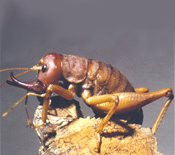
The friendly gentle giant insect .....
The male tusked weta looks all set for battle with its fearsome tusks (used to butt other males) and armour plating on its back. They appear even more scary when raising their long spiny back legs in defence.
Maori in the Hauraki Gulf call giant weta 'Wetapunga' after the god of bad looks, and in the South Island they are known as 'Taipo' which means demon.
Also known as 'devils of the night', they hardly live up to this bad name and are harmless to humans unless provoked, because they are mainly herbivores. A weta is quite content sitting on people and will not bite or scratch if they do not feel threatened.
Any species surviving for such a very long time, outliving dinosaurs and making it through ice ages, has to be pretty tough.
When turn of the 20th century naturalist Sir Walter Buller needed dead weta for his collection, he kept one under water for four days. Incredibly, it kept living, as did another that was dropped in near boiling water. OUCH! It is known that weta can survive in freezing climate conditions, despite their lack of an antifreeze agent that other animals have to tolerate cold.
|
|
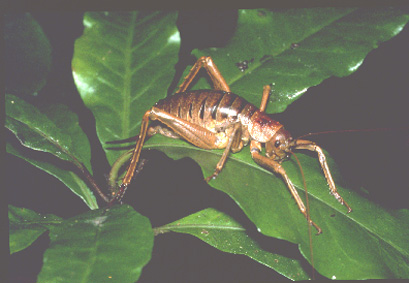 |
| |
Until recently, there has been little scientific research on weta. The many different types of weta can be categorised as tree weta, ground weta, cave weta, and the spectacular tusked weta.
A strong physical characteristic is the extremely long antennae, which are normally twice the body length, however, the cave weta has antennae that are four times longer than its body. As far as insects go, weta have long lives, with 18 months to two years to adulthood, and then another six months to two years as an adult. |
| |
Tusked weta - the insect find of the century .....
All of the three species of tusked weta (shown top) are recent discoveries. The Middle Island tusked weta that is carnivorous and has been named "Jaws", was found in 1970 by lizard expert Tony Whittaker in the Mercury Islands off the east coast of the Coromandel Peninsula. Another species was found in 1995 in the Raukumara Range on the East Coast of the North Island. Tusked weta are so named because the males have two tusks which they use to butt other males, or rasp together to warn off competitors.
A hundred Middle Island tusked weta raised by the Auckland Zoo and Landcare Research were released on rodent-free Red Mercury and Double Islands in 2000. These translocations will provide backup populations for the first tusked weta found on adjoining Middle Island.
Sixteen of New Zealand's wetas are at risk. Giant weta were once widespread throughout North Island lowlands. The Mahoenui giant weta was thought to be extinct on the mainland, until 1962 when a colony was rediscovered in an isolated King Country gorse patch. Department of Conservation biologists translocated 200 of them from the colony, south of Te Kuiti to Mahurangi Island off the Coromandel Coast, where they are breeding after four years. |
| |
Giant wetas return to mainland after a 100-year absence
In 2007, 100 rare Cook Strait giant weta Deinacrida rugosa were released into the wild at the Karori Wildlife Sanctuary in Wellington. It is the first translocation to re-establish the species since they became extinct on the mainland over a century ago. At about 70mm long, and weighing up to 27gm, the mouse-sized insects are among the world's heaviest and most fearsome looking, however, they are much less ferocious than the smaller tree weta found in New Zealand homes and gardens.
The translocated weta were collected on Matiu (Somes Island) and released at two locations in the Karori sanctuary, where they will be protected from the rats and stoats that lead to their extinction everywhere, except a few offshore islands. Four transfers of 450 weta are planned over four years. |
| |
| |
New Zealand has an unusual earthworm fauna, including famous giant species that reach more than a metre in length. Earthworms can make up the majority of the animal biomass in native forests and are thought to be major drivers of forest ecology above and below ground.
The 173 species of New Zealand's native earthworms are another ancient remnant of Gondwana. Many of them are related to native worms of southern South America, the Falkland Islands, southern South Africa, New Caledonia and Australia.
Worms are unable to pass through salt water, and it is unlikely that birds assisted their migration, as worm cocoons are laid under the surface of the earth. As with the native frog, worm migration to New Zealand is best explained as across land before separation from the Gondwana continent.
|
|
North Auckland worm
Spenceriella gigantea
The most spectacular, and New Zealand's largest worm is the gigantic North Auckland worm Spenceriella gigantea, which reaches up to 1.4 metres (55 inches) long and 11 millimetres (0.4 in) in width. The burrows are up to 20 millimeters in diameter, reaching a depth of 3.5 metres. The Maori worm (or milk worm) can exceed 300 millimetres in length.
The most extraordinary thing about Spenceriella gigantea is that it luminesces
at night, so brightly it is possible to read by the light from one worm.
|
|
|
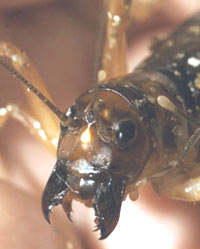
| |
International Threatened and Endangered Listings
2006 IUCN Red List of
Threatened Species
Poor Knights weta
Deinacrida fallai
Vulnerable
Wetapunga
Deinacrida heteracantha
Vulnerable
Kaikoura weta
Deinacrida parva
Data deficient
Stephen's Island weta
Deinacrida rugosa
Vulnerable
2005 New Zealand Threat Classification System
Ground weta
Hemiandrus 'Cape Campbell'
Nationally critical
Herekopare weta
Deinacrida carinata
Salmon 1950
Nationally endangered
Little Barrier giant weta
Deinacrida heteracantha
White 1842
Nationally endangered
Mahoenui giant weta
Deinacrida mahoenui
Gibbs 1999
Nationally endangered
Kaikoura giant weta
Deinacrida parva Buller 1895
Gradual decline
Karikari tree weta
Hemideina thoracica 2n=23,24
Gradual decline
Northland tusked weta
Anisoura nicobarica
Ander 1938
Sparse
Bluff weta
Deinacrida elegans
Gibbs 1999
Sparse
Mt Arthur giant weta
Deinacrida tibiospina
Salmon 1950
Sparse
Hawkes Bay tree weta
Hemideina trewicki
Morgan-Richards 1995
Sparse
Poor Knights giant weta
Deinacrida fallai Salmon 1950
Range restricted
Cook Strait giant weta
Deinacrida rugosa Buller 1871
Range restricted
Giant mole weta
Deinacrida talpa Gibbs 1999
Range restricted
Auckland Island weta
Dendroplectron aucklandensis
Range restricted
Poor Knights cave weta
Gymnoplectron giganteum Richards 1962
Range restricted
Ground weta
Hemiandrus bilobatus
Ander 1938
Range restricted
Ground weta
Hemiandrus subantarcticus Salmon 1950
Range restricted
Banks Peninsula ground weta
Hemideina ricta Hutton 1897
Range restricted
Snares Island weta
Insulanoplectron spinosum
Range restricted
Bounty Island weta
Ischyroplectron isolatum
Hutton 1895
Range restricted
Campbell Island weta
Notoplectron campbellense Richards 1964
Range restricted
Cave weta
Novoplectron serratum
Hutton 1904
Range restricted
Three Kings cave weta
Paraneonetus multispinus
Salmon
Range restricted
Cave weta
Talitropsis cassicruris
Hutton 1897
Range restricted
Cave weta
Talitropsis megatibia
Trewick 1999
Range restricted
Cave weta
Turbottoplectron unicolor
Salmon 1948
Range restricted
Ground weta
Hemiandrus 'Cromwell'
Range restricted
Ground weta
Hemiandrus 'disparalis'
Range restricted
Ground weta
Hemiandrus 'evansae'
Range restricted
Ground weta
Hemiandrus 'furoviarius'
Range restricted
Ground weta
Hemiandrus 'Horomaka'
Range restricted
Ground weta
Hemiandrus 'Kapiti'
Range restricted
Moehau weta
Hemiandrus 'Moehau'
Range restricted
Ground weta
Hemiandrus 'Okiwi'
Range restricted
Ground weta
Hemiandrus 'Onokis'
Range restricted
Ground weta
Hemiandrus 'Otekauri'
Range restricted
Ground weta
Hemiandrus 'Porters'
Range restricted
Ground weta
Hemiandrus 'saxatilis'
Range restricted
Ground weta
Hemiandrus 'vicinus'
Range restricted
Cuvier Island tree weta
Hemideina thoracica '2n=11,12'
Range restricted |
|



